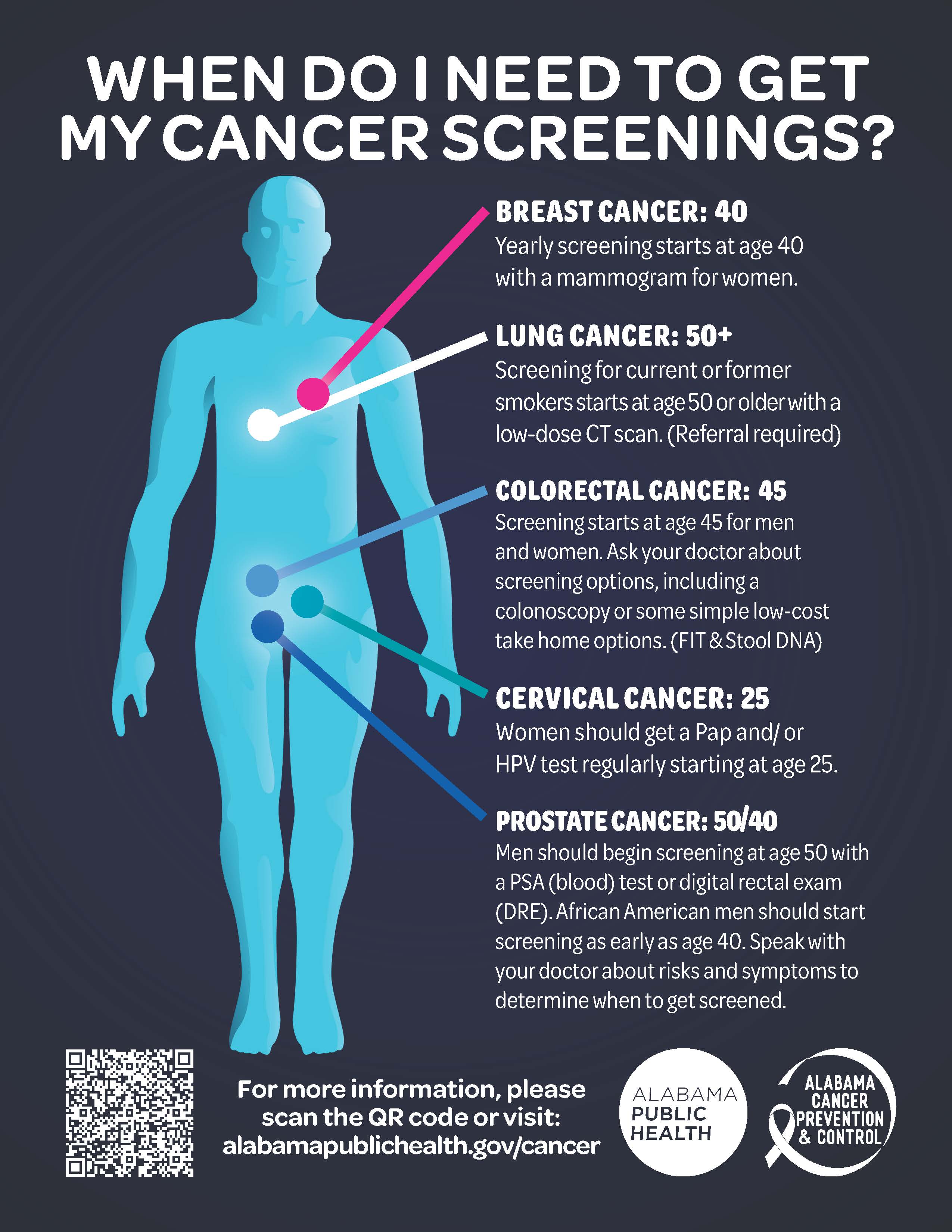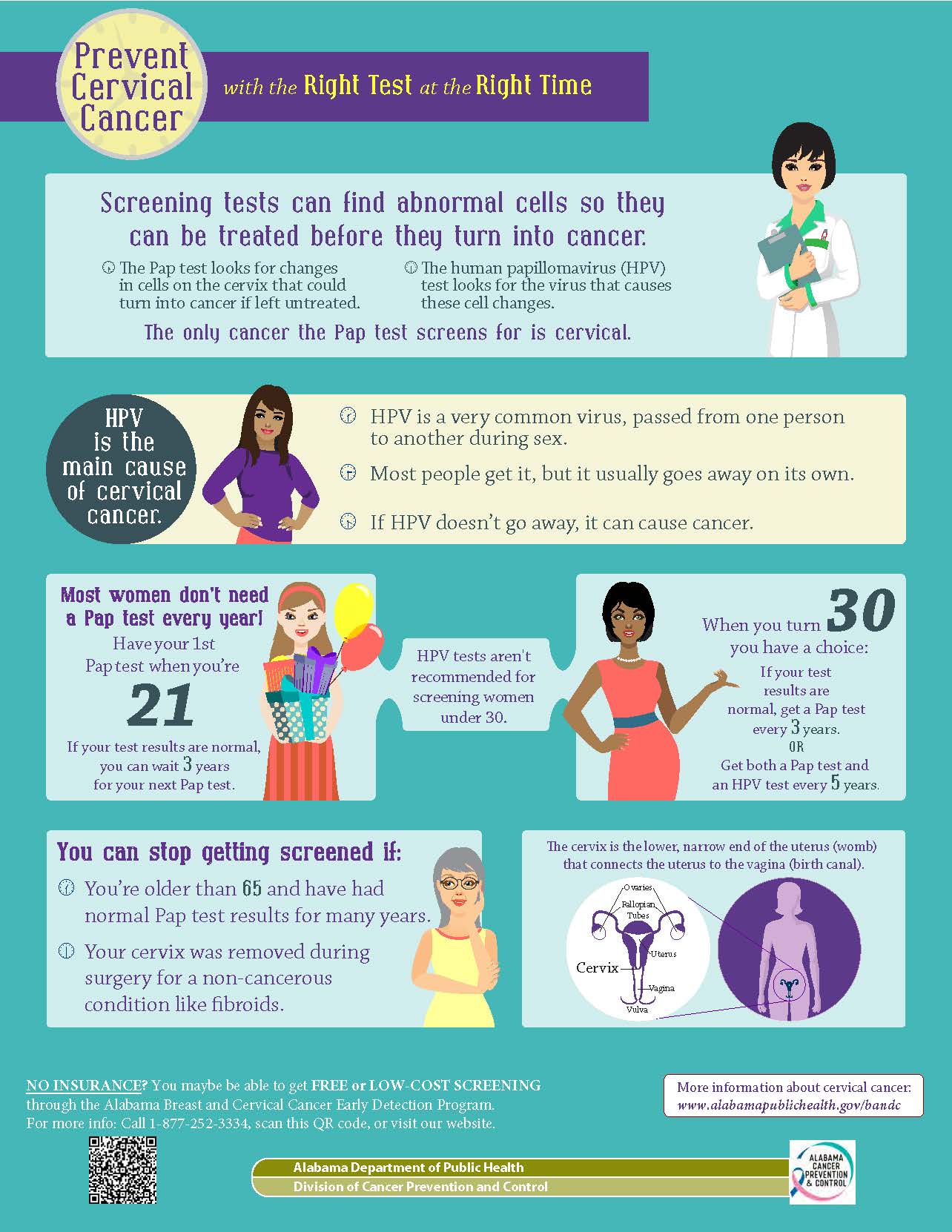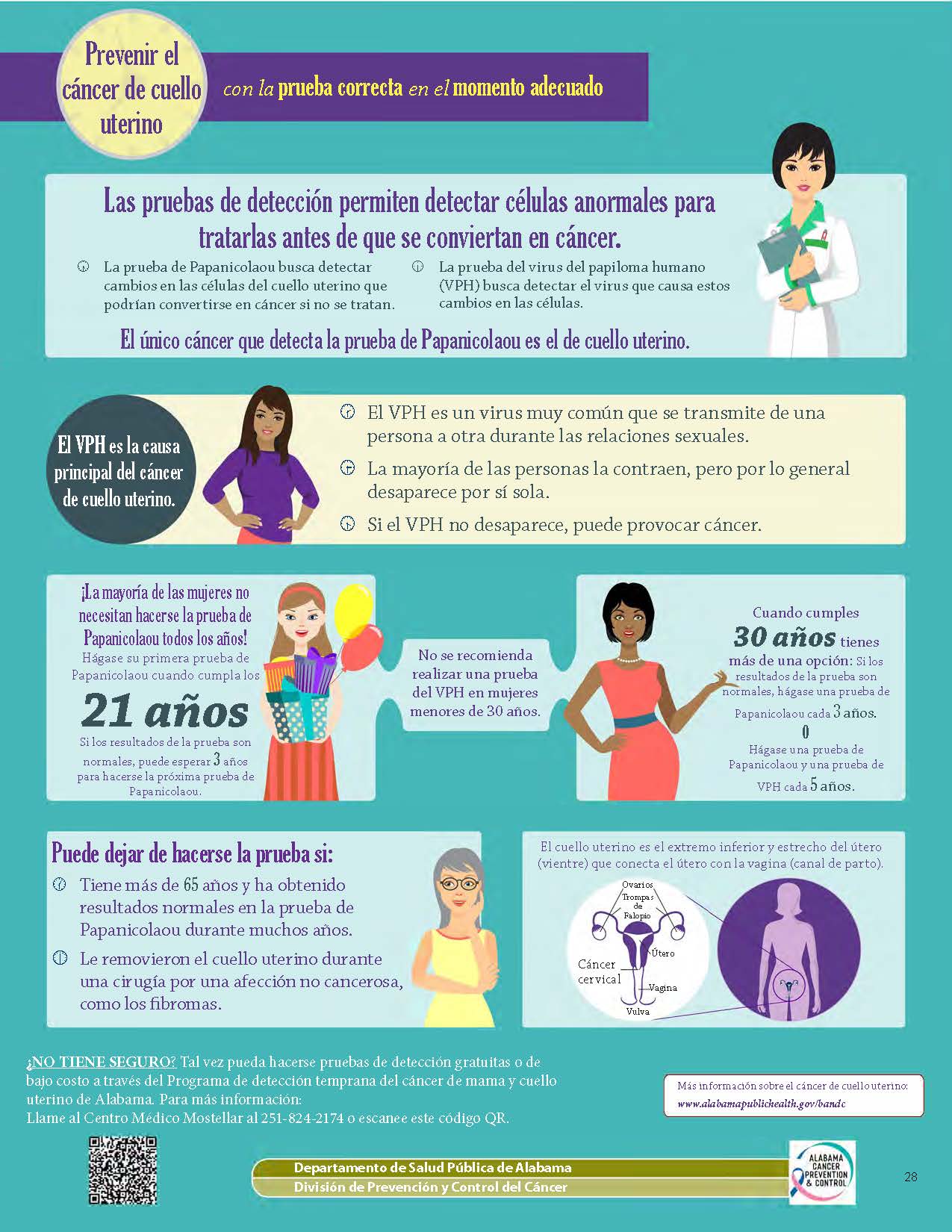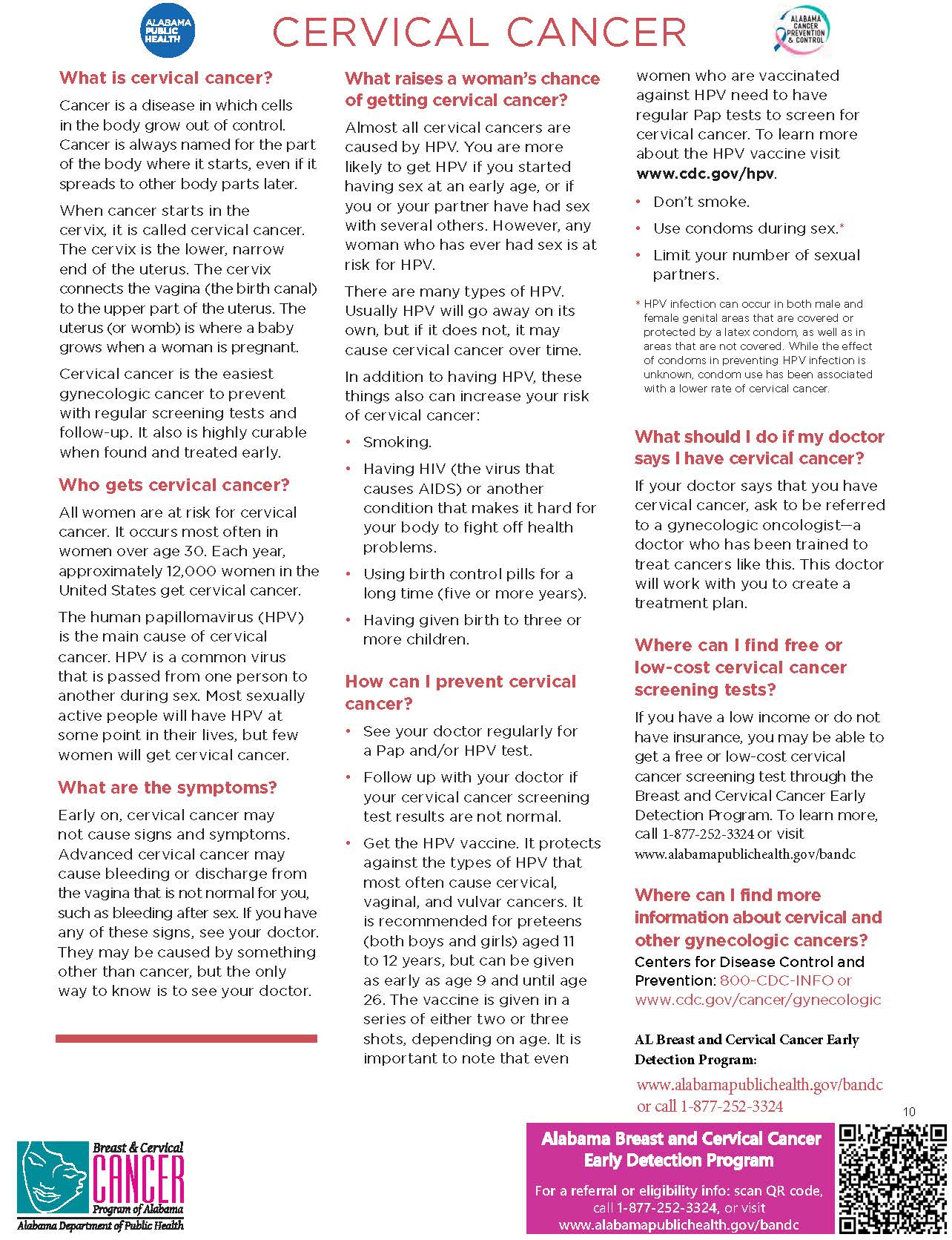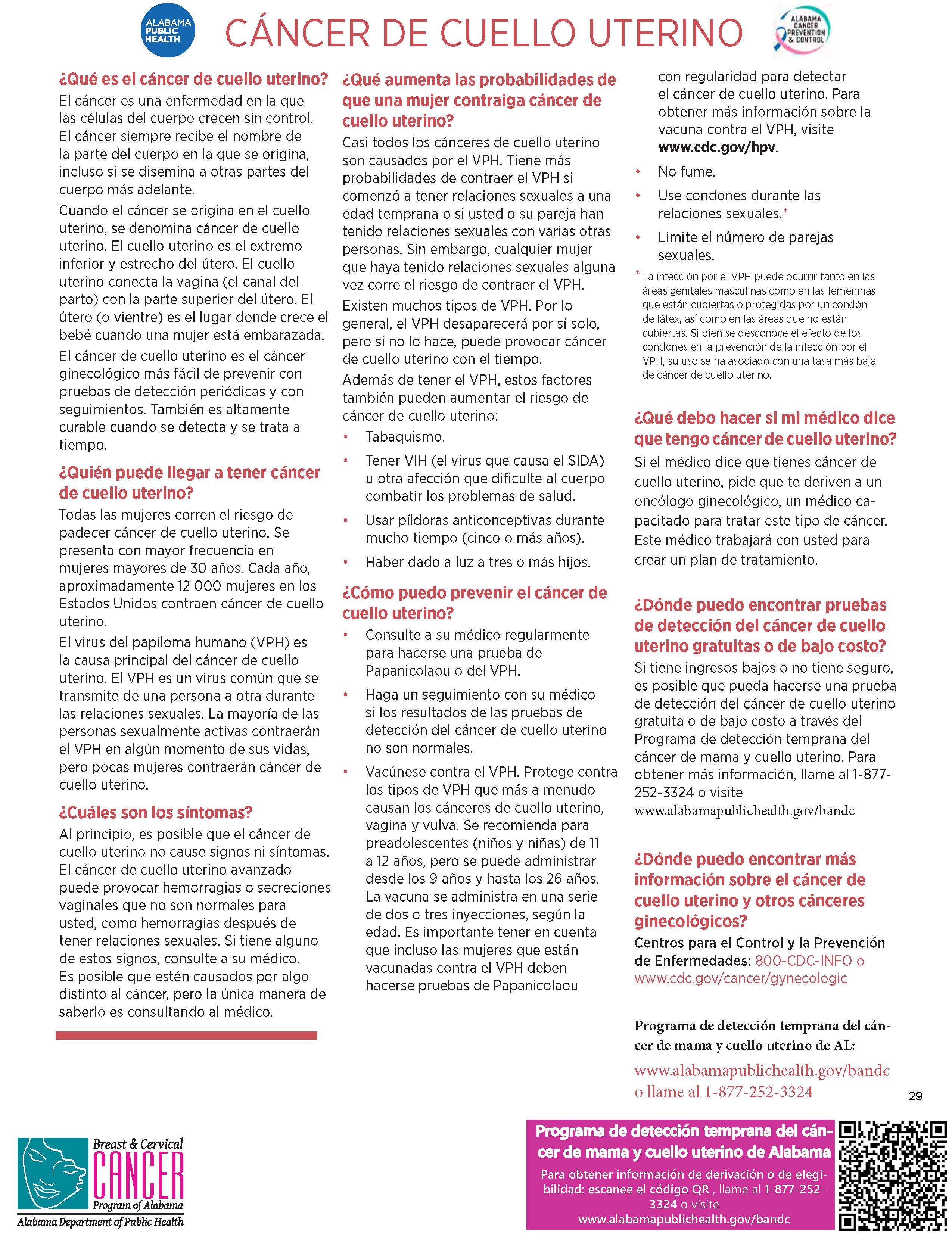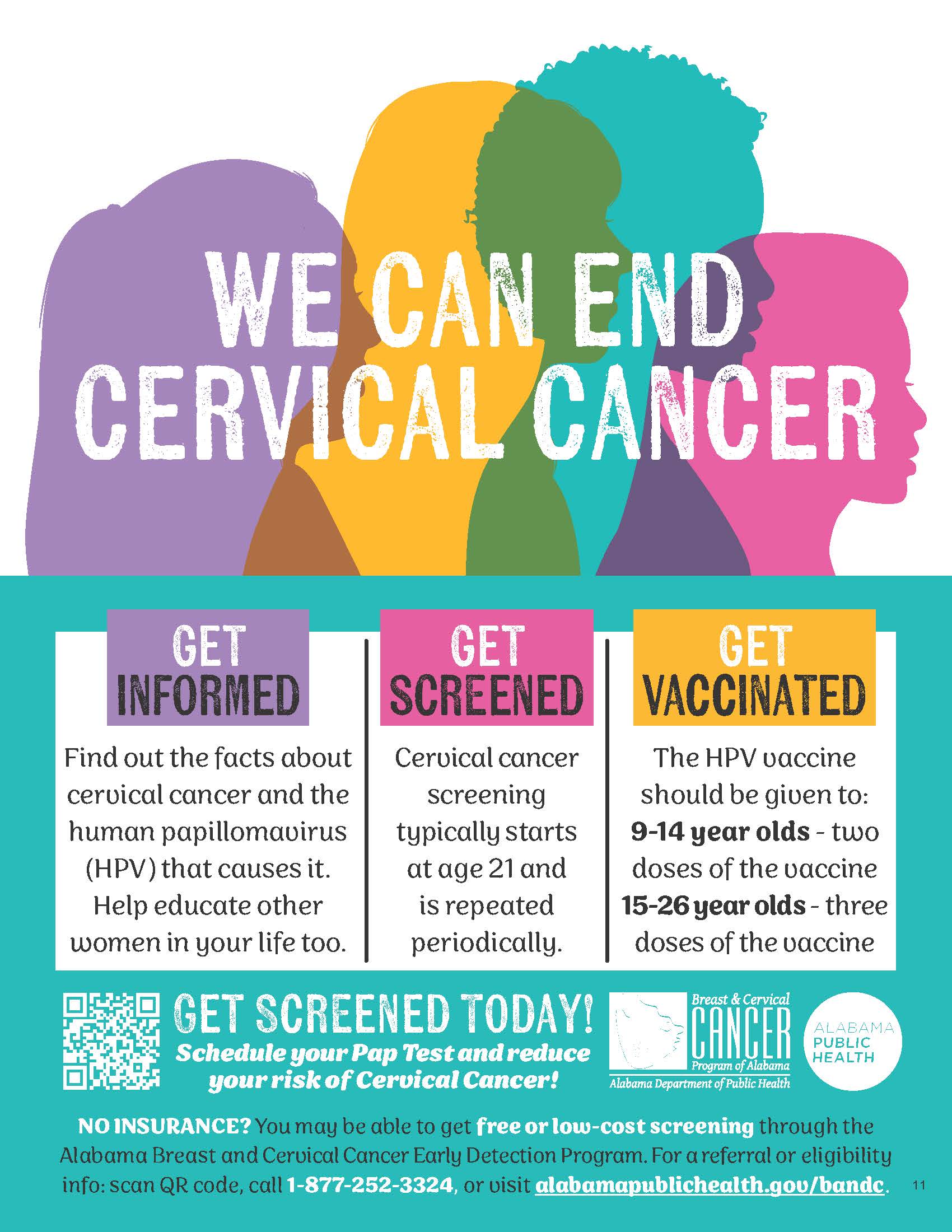- Cancer Division Home
- Cancer Control Coalition
- ASCR
- Breast & Cervical Cancer (ABCCEDP)
- Alabama WISEWOMAN Program
- Cancer State Plan
- Publications
- Breast Cancer
- Cervical Cancer
- Colorectal Cancer
- Lung Cancer
- Prostate Cancer
- Skin Cancer
- Survivorship: Life During and After Cancer
- HPV: Cervical Cancer Prevention
- Nutrition and Physical Activity
- Print Material
- Contact Us
SEE ALSO:
Cardiovascular Health
Diabetes
Nutrition and Physical Activity
Oral Health
Tobacco Prevention/Quitline
NEED HELP?
Having trouble finding what you are looking for? Use our A to Z Index.
Cervical Cancer
Cervical cancer is a cancer of the female reproductive system. All women, regardless of race, socio-economic status, education level, place of birth, or residence, are at risk of developing cervical cancer. However, not only is cervical cancer curable when found early, it can also be prevented. Despite this, Alabama routinely has one of the highest rates of cervical cancer incidence and mortality - significantly worse than the United States. Women are more likely to die in Alabama from cervical cancer than most other states in the nation.
Right now, Alabama ranks third in the nation for incidence and deaths from cervical cancer. This is unacceptable, as cervical cancer can be prevented and it can be stopped. How? Three steps:
- Increase Human Papillomavirus (HPV) vaccination.
- Increase cervical cancer screening: regular HPV/Pap tests.
- Appropriate follow-up tests if the screening results show abnormal cells.
We know how cervical cancer can be prevented
We know how to identify cervical pre-cancer and early stage invasive cancer and we know the importance of finding it early. We know how to treat pre-cancer and invasive cancer; successfully, if found early. We have the tools to prevent and detect this cancer early, and our state has the infrastructure through primary care providers, county health departments, and access to the best cancer care in the country.
How does cervical cancer occur?
The cervix connects the vagina to the uterus. There are two different types of cells in the cervix: flat squamous cells which line the outer cervix that projects into the vagina, and glandular column-like cells which line the cervical canal. Squamous cell carcinoma is a cancer of the squamous cells. The majority of cervical cancers are squamous cell carcinomas. Adenocarcinoma begins in the glandular cells. The two different types of cancers determine the outcome (prognosis) of the cancer and the types of treatment. It is possible to have both squamous cell carcinoma and adenocarcinoma at the same time. Almost all cervical cancer cases are caused by a viral infection from certain types of HPV. Two types are responsible for at least 70% of cancer cases, types 16 and 18.
Why do you need to be screened for cervical cancer?
By the age of 50, at least 4 out of 5 women will have been infected with HPV and 10% of women will develop lasting HPV infections, placing them at greater risk of developing cervical cancer. Usually, the body’s natural immune system can overcome or end the infection within 2 years. When the body cannot rid itself of the HPV infection, the cancer-causing HPV types can linger and turn normal cervical cells into abnormal and then cancerous cells. To determine if you are at risk for cervical cancer due to a lasting HPV infection, women should go to their doctor for cervical screening. It is essential to screen for and remove abnormal cells caused by HPV before they can become cancerous. Cancer screening involves taking a sample of cells to determine if HPV, precancerous cells, or cancerous cells are present.
See if you qualify for the Alabama Breast and Cervical Cancer Early Detection Program (ABCCEDP).
What are the risk factors for cervical cancer?
Almost all cervical cancers are caused by persistent infection with certain types of HPV. However, these infections are common in healthy people with a cervix and only rarely cause cancer. Individuals who begin having sex at an early age, who have had many sexual partners, or male partners who have had many sexual partners, are at increased risk for HPV infection. Other risk factors for developing cervical cancer include being immunocompromised, being overweight or obese, using contraceptives long-term, having given birth to 3 or more children, and smoking.
How can cervical cancer be prevented?
The best way to prevent cervical cancer is through vaccination. The HPV vaccine protects against the types of HPV that cause over 90% of all cervical cancers as well as numerous other cancers and diseases. Routine cancer screenings can prevent cervical cancer by detecting and treating precancerous cells. The recommended screening method is a combination of the HPV test and the Papanicolaou (Pap) test. Screening involves a simple procedure where a small sample of cells is collected from the cervix and examined under a microscope. The HPV test can detect HPV infections associated with cervical cancer as well as identify individuals at risk for adenocarcinoma of the cervix. This type of cervical cancer makes up approximately 30% of cases and can be missed by the Pap test. Co-testing with both HPV and Pap tests is recommended.
What are the signs of cervical cancer?
There may be no physical signs of cervical cancer in the early stages. This is why it is so important for a woman to get screened regularly. If the cancer is caught early or in its precancerous form, it can be removed before it spreads. Symptoms of more advanced forms of cervical cancer can include vaginal bleeding after sex, vaginal bleeding between periods or after menopause, watery or bloody vaginal discharge that may be heavy or have a foul odor, and pelvic pain or pain during or after intercourse.
Operation Wipe Out Cervical Cancer Alabama
Operation Wipe Out Cervical Cancer Alabama has launched a statewide action plan to eliminate cervical cancer.
Alabama ranks third in the nation in the incidence and deaths from cancer that can be prevented, cervical cancer. To address this serious public health problem, primary care providers and community leaders from throughout the state convened and developed a statewide action plan to eliminate cervical cancer in Alabama by 2033. The launch of “Operation Wipe Out Cervical Cancer Alabama” was announced at a news conference on May 8, 2023.
The statewide plan is the result of a summit held in Birmingham in the fall of 2022, where primary care providers and public health leaders representing 42 of the 67 Alabama counties came together to identify barriers, facilitators, and solutions to cervical cancer prevention and control in Alabama.
Partners with the Alabama Department of Public Health (ADPH) are the University of Alabama at Birmingham (UAB) Department of Obstetrics and Gynecology and O’Neal Comprehensive Cancer Center, TogetHer for Health, Rotary Club of Birmingham, and the American Cancer Society.
The statewide action plan uses evidence-based strategies to promote HPV vaccination, promote cervical cancer screening, and ensure adherence to follow-up in the event of cervical cancer screening abnormal results. HPV vaccinations are a powerful tool to protect children and adolescents before they are exposed to the virus. Cervical cancer screening among women 21 to 65 years of age detects abnormal cells in the cervix, which can develop into cancer. Appropriate follow-up and treatment for women with abnormal results improve the chance of recovery from cervical cancer. Specific benchmarks will be monitored toward the achievement of this goal.
“The launching of the statewide action plan is a historic milestone in the fight against cervical cancer in Alabama,” Nancy Wright, Director of the ADPH Cancer Prevention and Control Division, said. “It is an opportunity for all segments of society to get involved, including parents, physicians, business leaders, community-based organizations, public health systems, and academic centers.”
- Read the news release.
- Watch the news conference.
- View the CDC documentary.
- View the Alabama documentary.
- Attend Operation Wipe Out Regional Meetings.
- "We can end Cervical Cancer in our lifetime. Alabama’s women need only take three steps to WIPE OUT this deadly cancer."
(Op-ed piece written by Cancer Prevention and Control Division Director Nancy Wright)
Resources
- Wipe Out Cervical Cancer in 3 Steps
- Wipe Out Cervical Cancer Alabama
- Wipe Out Cervical Cancer Alabama, Spanish Version
- HPV & Cervical Cancer PowerPoint Presentation
Why Should You Get Screened for Cervical Cancer?
“Under The Paper Gown”: A Comedy Web Series
Cervical Cancer Statistics
Educational Flyers
Page last updated: December 20, 2024
SEE ALSO:
Cardiovascular Health
Diabetes
Nutrition and Physical Activity
Oral Health
Tobacco Prevention/Quitline
NEED HELP?
Having trouble finding what you are looking for? Use our A to Z Index.


